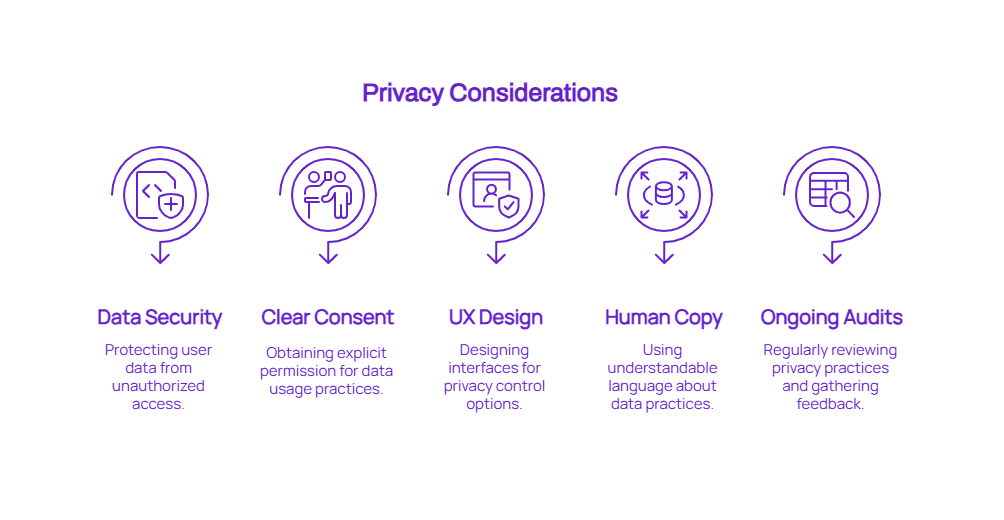Data- and privacy-related trust matters in all software applications, but it is everything in healthcare. If users don’t feel safe sharing their data, or don’t understand what’s happening with it, they’ll drop your app faster than you can say “HIPAA.”
As a HealthTech product, your app deals with personal health info, clinical decisions, or patient monitoring. It is shaping experiences that affect lives. It’s a part of people’s well-being.
So, how do you get people to trust your product?
Strong data protection combined with respectful consent flows and clear design showcasing empathy and care. That’s how.

In this blog post, we’ll break down these three pillars of trust in HealthTech apps: security (keep sensitive data protected), consent (have transparent, user-friendly permissions), and UX (make users feel confident and in control).
1. Prioritize Data Security from Day One
Trust starts with airtight data protection. If your app can’t guarantee that users’ health data stays secure, nothing else matters.
So, begin by getting all the basics right: data encryption at rest and in transit, role-based access control (RBAC), and secure authentication.
However, it also means thinking like an attacker. What happens if someone intercepts API calls? Are there unguarded endpoints? Are you logging sensitive data without realizing it?
Healthcare data is 20x more valuable than credit card info on the black market. That’s why healthcare apps are a prime target for breaches.
All things considered, your app needs:
- End-to-end encryption (AES-256 or equivalent)
- OAuth 2.0 or OpenID Connect for authentication
- Granular permissions to control what each user can access
- Regular security audits and pen tests
- A secure DevOps setup with CI/CD checks for vulnerabilities
And then there’s compliance, which is a baseline for credibility. Depending on where you operate, you’re likely bound by HIPAA, GDPR, PHIPA, or some combination of these three and more.
When users know their data is handled responsibly, they stay. When they sense even a whiff of carelessness, they leave.
2. Be Transparent and Respectful About Consent
Users don’t appreciate surprises, especially when it comes to their health data.
If your app is collecting, sharing, or storing personal information, users need to know what, why, and for how long. Not in fine print. Not buried in a 50-page policy. But right there, in plain language, before anything happens.
Consent is a legal checkbox, but more than that, it’s a moment of trust.
Build it thoughtfully:
- Use clear, simple language. Skip the legalese.
- Explain what you’re collecting, how it’s used, and who sees it. Mention HIPAA/GDPR/PHIPA consent requirements briefly.
- Give users control with toggle options and revocable permissions.
- Use progressive consent flows that ask only when relevant and necessary. Avoid overwhelming users with prompts.
- Let people opt out without punishment (where possible).
Also, tailor consent to the situation. Sharing location data for emergency care is different from using it for marketing. Be clear about the context and let the user decide.
Respect and transparency lead to trust. This trust builds adoption and retention.
3. Apply UX Principles That Reinforce Safety and Credibility
Security and consent don’t mean as much if the app feels confusing or chaotic.
A cluttered interface, unclear buttons, or awkward flows can make users second-guess what they’re doing and whether their data is really safe.
You need a thoughtful UX strategy to tackle this. Good UX makes your app look good, and it reassures users by letting them feel in control of everything.
Here’s how to design with trust in mind:
- Use visual cues like lock icons or secure labels to show when data is protected.
- Keep flows predictable and simple. Don’t make users guess what’ll happen next.
- Make permission requests and alerts feel friendly, not invasive.
- Highlight safety moments, such as a confirmation message when data is securely saved.
- Provide easy access to support and clear ways to ask questions.
At the same time, avoid dark patterns. Don’t trick users into enabling features they don’t want or having them give up more data than necessary. Give them real choices and respect their decisions.
Also, frequently run usability tests with patients and clinicians on key trust points (like onboarding, data sharing, and permissions).
Good design earns trust explicitly as well as in the background, one click at a time.
4. Further Humanize the Experience Through Design
Even the most secure, compliant, and smooth-flowing app can feel cold if it lacks a human touch. Healthcare is personal. Your app should reflect that through its language, design, and every interaction.
Start with clear, conversational microcopy. Avoid jargon. Speak the way real people speak, especially when you’re asking for sensitive info or explaining tough choices.
Give users control over their experience. Let them adjust settings, change permissions, or reach support easily. Friction leads to frustration. Control builds confidence.
And don’t stop at functionality. Bake credibility into the UI:
- Add real testimonials from clinicians or patients.
- Display certifications or security badges where they matter.
- Include FAQs or tooltips that answer common concerns.
When possible, go a step further. Show users they’re not alone:
- Add the name of a care provider during onboarding.
- Offer a real support contact, not a faceless bot.
- Use photos, bios, or short intros to introduce the team behind the app.
When users feel heard and supported, they trust more and stay longer.
5. Audit, Monitor, and Improve Over Time
Trust isn’t a switch you set once and forget. It needs upkeep.
Security threats evolve. User expectations shift. Compliance rules change. If your app stays the same while everything around it moves, cracks will show.
So, stay proactive:
- Run routine security audits internally and with third-party experts.
- Set up real-time monitoring to catch threats before they spread.
- Keep logs and audit trails for sensitive actions.
- Revisit your consent flows every few months. Are they still clear? Are they still relevant?
And don’t guess what users think. Build in feedback loops, especially around moments that affect trust, like permissions, onboarding, or data-sharing flows. What’s confusing? What feels invasive? Get answers straight from the horse’s mouth.
Use analytics to find friction points. Are people dropping off when you ask for access to health data? Do they abandon onboarding halfway through? That’s bad UX and a trust issue.
The best HealthTech apps treat trust like a product feature and improve it with every release.
Build Trustworthy HealthTech Apps With SoluteLabs
In any software, data-related user trust is never a nice-to-have. It’s essential. In HealthTech, though, it’s a core feature.
If people feel their data is safe, their choices respected, and their experience smooth, they’ll stick with your app. If not, they’ll leave. Simple as that.
So, focus on the basics: Protect sensitive data. Ask for consent the right way. Design with clarity, care, and respect.
Get those three right, and you have a strong foundation to build on. Prioritizing security, consent, and UX means right from the off means you’re already ahead of most in terms of earning and retaining user trust.
If you’re building something in this space, we can help. SoluteLabs has worked with health startups and enterprise teams alike to ship secure, usable, and regulation-ready software.
Get in touch with us to create apps people trust.







